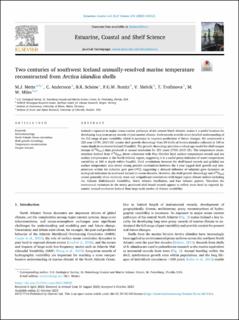| dc.contributor.author | Mette, Madelyn | |
| dc.contributor.author | Andersson, Carin | |
| dc.contributor.author | Schöne, B.R. | |
| dc.contributor.author | Bonitz, Fabian | |
| dc.contributor.author | Melvik, V. | |
| dc.contributor.author | Trofimova, Tamara | |
| dc.contributor.author | Miles, Martin W. | |
| dc.date.accessioned | 2023-11-28T14:55:32Z | |
| dc.date.available | 2023-11-28T14:55:32Z | |
| dc.date.created | 2023-11-23T14:19:56Z | |
| dc.date.issued | 2023 | |
| dc.identifier.citation | Estuarine, Coastal and Shelf Science. 2023, 294 (5), . | en_US |
| dc.identifier.issn | 0272-7714 | |
| dc.identifier.uri | https://hdl.handle.net/11250/3105077 | |
| dc.description.abstract | Iceland's exposure to major ocean current pathways of the central North Atlantic makes it a useful location for developing long-term proxy records of past marine climate. Such records provide more detailed understanding of the full range of past variability which is necessary to improve predictions of future changes. We constructed a 225-year (1791–2015 CE) master shell growth chronology from 29 shells of Arctica islandica collected at 100 m water depth in southwest Iceland (Faxaflói). The growth chronology provides a robust age model for shell oxygen isotope (δ18Oshell) data produced at annual resolution for 251 years (1765–2015 CE). The temperature reconstruction derived from δ18Oshell shows coherence with May–October local surface temperature records and sea surface temperatures in the North Atlantic region, suggesting it is a useful proxy indicator of water temperature variability at 100 m depth within Faxaflói. Field correlations between the shell-based records and gridded sea surface temperature data reveal strong positive correlations between the 1-year lagged shell growth and temperatures within the subpolar gyre post-1972, suggesting a delayed influence of subpolar gyre dynamics on ecological indicators in southwest Iceland in recent decades. However, the shell growth chronology and δ18Oshell record generally show relatively weak and insignificant correlations with larger region climate indices including the Atlantic Multidecadal Variability, North Atlantic Oscillation, and East Atlantic pattern. Therefore the interannual variations in the newly produced shell-based records appear to reflect more local to regional dynamics around southwest Iceland than large-scale modes of climate variability. | |
| dc.language.iso | eng | en_US |
| dc.rights | Attribution-NonCommercial-NoDerivatives 4.0 Internasjonal | * |
| dc.rights.uri | http://creativecommons.org/licenses/by-nc-nd/4.0/deed.no | * |
| dc.title | Two centuries of southwest Iceland annually-resolved marine temperature reconstructed from Arctica islandica shells | en_US |
| dc.title.alternative | Two centuries of southwest Iceland annually-resolved marine temperature reconstructed from Arctica islandica shells | en_US |
| dc.type | Peer reviewed | en_US |
| dc.type | Journal article | en_US |
| dc.rights.holder | © 2023 Elsevier | |
| dc.description.version | publishedVersion | |
| cristin.ispublished | true | |
| cristin.fulltext | original | |
| cristin.qualitycode | 1 | |
| dc.identifier.doi | 10.1016/j.ecss.2023.108525 | |
| dc.identifier.cristin | 2201116 | |
| dc.source.journal | Estuarine, Coastal and Shelf Science | en_US |
| dc.source.volume | 294 | en_US |
| dc.source.issue | 5 | en_US |
| dc.source.pagenumber | 11 | en_US |

